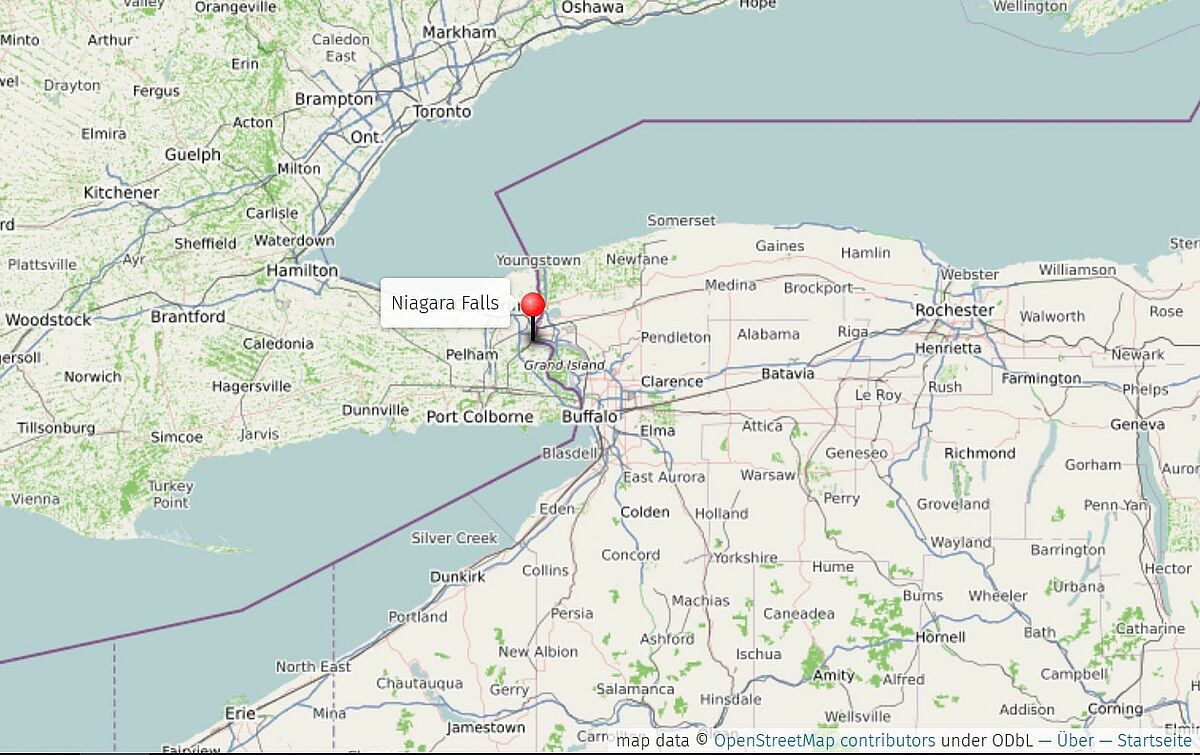Niagara Falls and the Maid of the Mist
by Alexander Bräuer, 01/11/2019.
Summary
The Maid of the Mist is nowadays, due to the tourism industry, without a doubt the most popular story about Niagara Falls. However, the story often serves a superficial, exotic role, supplementing the visual experience . It is seldom seen against the background of the colonial history of Niagara Falls as well as the significance of waterfalls as landmarks. A closer look at the story reveals not only the fluid character of the geographical feature and the local human settlement but shows how the Maid of the Mist story emerged at the beginning of the nineteenth century in the imaginative contact zone between Indigenous and settler colonial cultures. It shows that Niagara was not only important for the then fading fur trade but increasingly for the upcoming tourism industry driven by romantic ideas. Indeed, the story itself is characterized by a fluid character, thereby not only showing its long history but testifying to the resilience of Indigenous cultures.
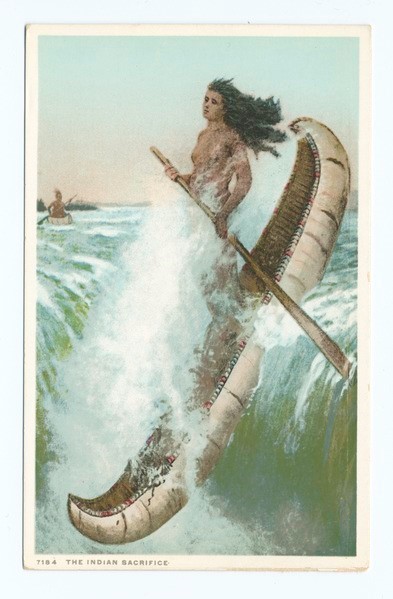
Waterfalls as Landmarks
Waterways were the lifelines of the economy in the Northeast of North America for hundreds of years, especially in the area around the Great Lakes where big cargoes could be transported with relative ease along the rivers and lakes of the region. This was true for the Indigenous population of the area as well as for the European colonizers. In this system of waterways, waterfalls had an ambivalent function. On the one hand, they represented a physical barrier, an obstruction, and an inherent danger for the trade along the waterways. The cargo had to be unloaded, transported (employing considerable manpower) over trails bypassing the falls, and refloated afterwards. More often than not the canoes and boats had to go the same way. And all this had to be achieved under difficult environmental circumstances (challenging geographic terrain, noise, humidity, abundance of snakes, etc.), which did not exactly favor human settlement. On the other hand, waterfalls opened up opportunities for the local population to control and profit from the trade. Consequently, the European newcomers targeted these junctions specifically, tried to use the infrastructure already established by the Indigenous population (for example in the form of trails), and built military forts in order to solidify their control over the trade routes.
The economic significance of waterfalls translated into the cultural life and identity politics of the affected populations, the Indigenous population as well as the European newcomers. Waterfalls feature heavily in various Indigenous stories and became focal points for the (travel) literature and the tourism industry of the European newcomers. Thus, waterfalls, by combining economic and cultural significance, became important and heavily contested landmarks, here in the Northeast of North America just as in the Pacific Northwest, where colonization consisted of a prospering fur trade with powerful Indigenous nations. Niagara Falls – sometimes referred to as the “door to the west” (Strand, 17) – situated at the junction between Lake Erie and Lake Ontario (the Niagara River), constituted one of the most prominent examples of such important, strategic landmarks.
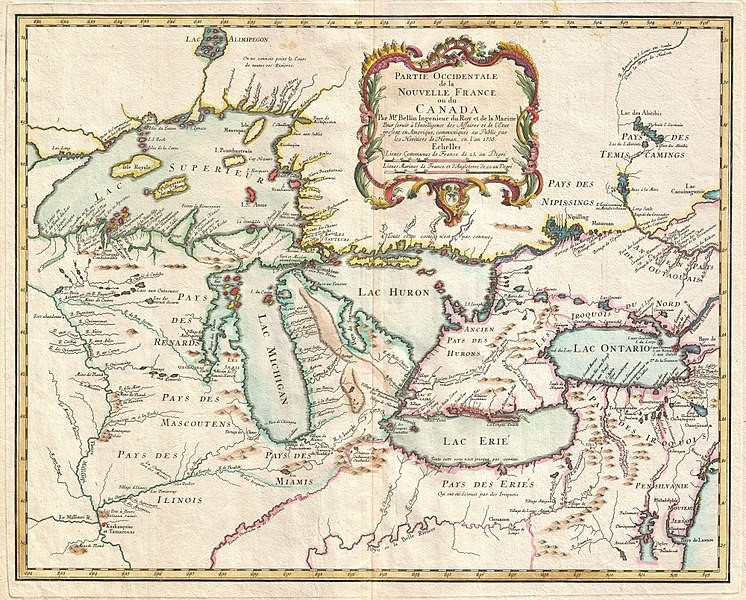
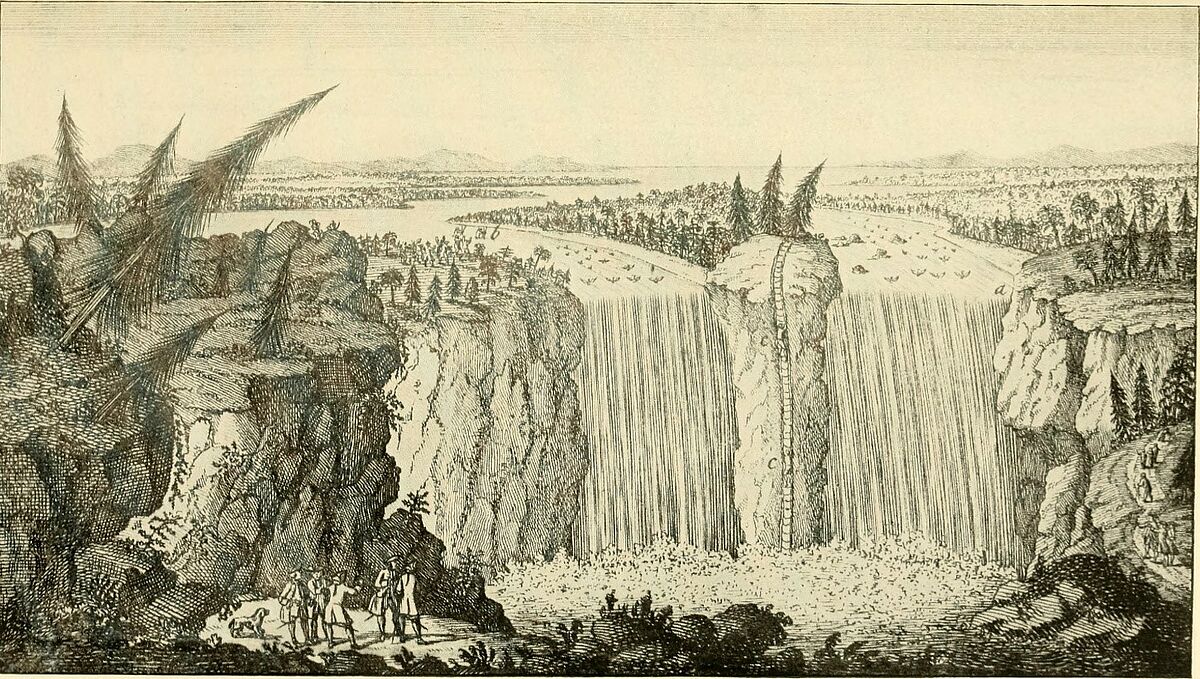
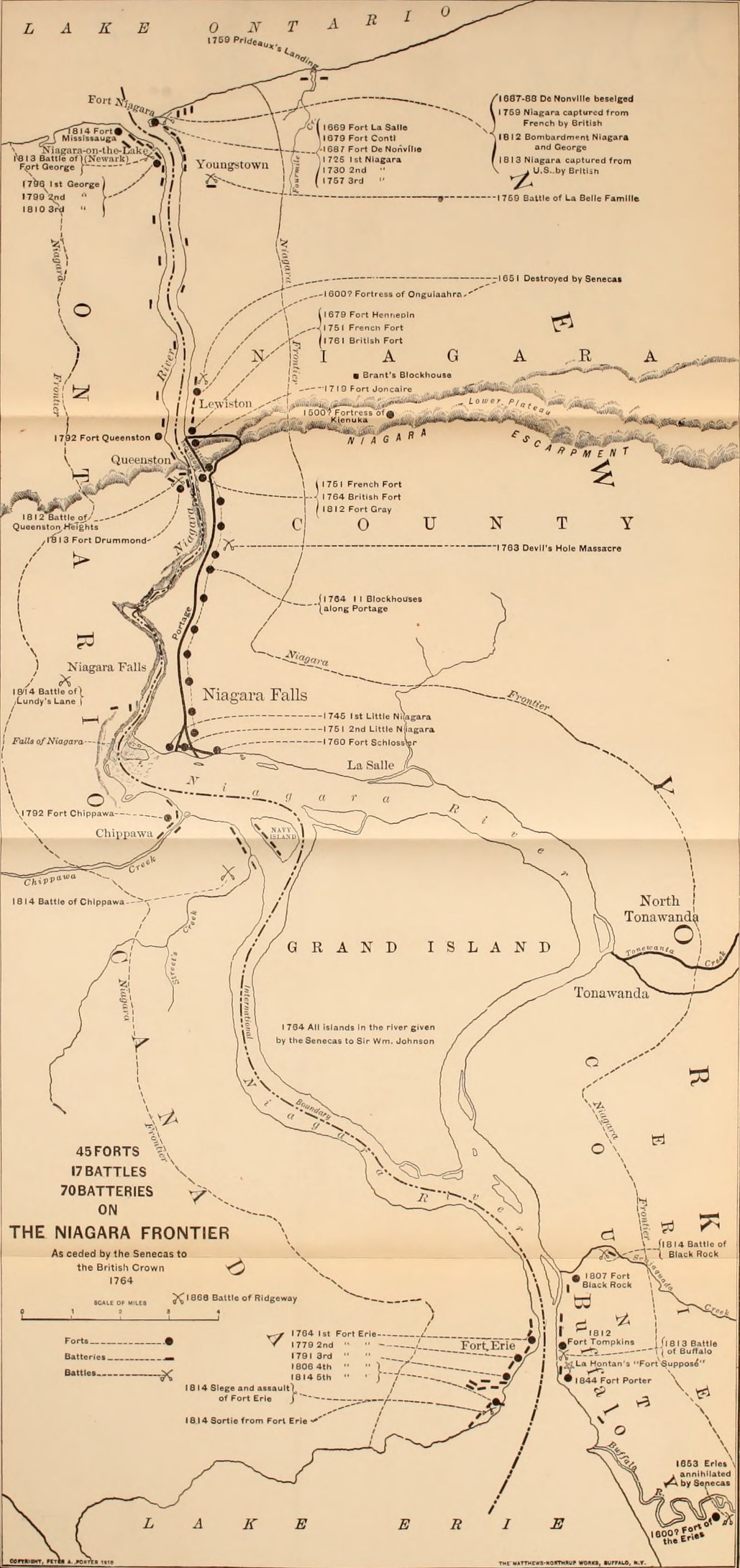
A Very Short History of Niagara Falls
Niagara Falls – consisting of three different waterfalls (the Horseshoe Falls, the American Falls and the Bridal Veil Falls) – was the result of the Wisconsin glaciation that (re)shaped the whole river and lake system of the region 10,000 years ago. The name of the Falls probably derives from the earliest known Indigenous population in the area, the Neutral Nation or Onguiaronon (“People of the Thundering Waters”), whose name was first recorded by Samuel de Champlain and later anglicized into “Nee-ah-guh-ah” (Revie, 2). Not much is known about the earliest people in the area, who most likely were absorbed by the Seneca Nation in the 1640s and 1650s. The Seneca, a Nation of the Iroquois Confederation, took over and controlled the carrying-places (a term used by both Europeans and Indigenous peoples and referring to the extensive physical labor connected to the transportation of goods and travelers around the waterfalls) around Niagara Falls until the European colonizers dispossessed the Indigenous population.
The dispossession of the Seneca at Niagara Falls took place in three steps, which can be linked to the three different European empires (and their modus operandi) operating in the region: the French, the British, and the American Empire. In 1678, the French Empire established a fort at the mouth of Niagara River on Lake Ontario, close to Niagara Falls, and thereby exercised military power over the region (and the trade at the Falls). Thus, the Seneca lost the ability to deny access to the trade route. However, the French Empire was mostly content with exercising military and symbolic power over the waterfalls and the Seneca Nation maintained their control over the portage system, the labor, and thus over the economic operations. In a second step, the French lost control over Fort Niagara during the French and Indian War in 1759, and the British installed a portage system ignoring the needs and experience of the Indigenous population living nearby (MacLeitch, 178 & 180). In a last step, the American government, which established control over the area around 1796) declared in the 1830s its will to deport the Tuscarora, the local Seneca tribe, from their lands. The deportation to the Indian Territory (the later state of Oklahoma) was considered justified “unless [the Tuscarora] could demonstrate economic self-sustainment”, a category Native Americans could seldom achieve following the ramifications of settler colonialism (Sehdev, 244). Subsequently, Goat Island, the island between the American and Canadian Falls, was sold to an investor and transformed into a tourist destination.
These three steps spanned a timeframe of roughly 150 years and were frequently met by a massive – and sometimes successful – resistance from the Indigenous peoples who knew about the economic and cultural value of Niagara Falls. The Seneca, for example, fought repeatedly for their rights to control the trade surrounding Niagara Falls – most prominently probably during Pontiac’s War. However, even after the “formal” dispossession by the American Empire in the 1830s, the Indigenous presence remained visible at Niagara Falls. This was even true when the meaning of Niagara Falls as a landmark began to change at the beginning of the nineteenth century. First, the Niagara River lost its importance for the trade in the area following the construction of the first Welland Canal (completed in 1833), which opened up a direct route through the Niagara Peninsula and bypassed the Falls. On the other hand, and with the building of the Erie Canal starting in 1817, the whole region became accessible to tourists from the New York area (Gassan, 97), which in turn helped to develop the waterfalls into the capitalistic tourist attraction familiar to us. Thus, the canal building era has to be seen as the most significant time for the shaping of the landmark. It erased the function of the Falls for the trade while at the same time making the waterfalls more easily accessible and thereby creating new functions: that of a tourist attraction and, beginning in the late nineteenth and early twentieth century, that of a place for the generation of electric power. During these changes Indigenous people remained in the area and maintained their connection to the land and Niagara Falls by working in the new tourist industry. A visit to the “Indian village”, souvenirs in the form of beadwork as well as Indian restaurants all became part of the Niagara experience. Their presence provided another level of authenticity to the touristic experience of Niagara Falls (Sehdev, 244.). Thus, starting in the early nineteenth century, Niagara Falls changed its character completely by becoming a destination in its own right, instead of a transit place which had to be circumvented in order to get to a destination.[1]
The carrying-place / portage place disappeared and was replaced by a service-place no longer haunted by the danger of the Falls but inspired by its sublime beauty and massive appearance. To put it in other words and coming back to the ambivalence of the place: the economic significance was/is now produced by its cultural significance.
The Maid of the Mist
Understanding the complex history of Niagara Falls is essential in order to get a feeling for the legends and stories surrounding the landmark. This is especially true for the most prominent story about Niagara Falls, the Maid of the Mist, a story about an Indian Maiden that is heavily featured in the tourism industry of the Falls. Here, I will focus on a very early version of the Maid of the Mist published by Lewis Henry Morgan in his League of the Ho-de-no-sau-nee or Iroquois from 1851, which was heavily influenced by Ely S. Parker, a prominent member of the Seneca Nation. It had its roots in Native American culture as well as in the various developments surrounding Niagara Falls, navigating on the intersections between settler colonial ideas of the dispossession of the Indigenous people, the fading memories of the Falls as carrying-place, and the upcoming new tourism industry influenced by romantic ideas. The story begins with a strong romantic figure:
A young maiden residing at Gä’-u-gwa, a village above Niagara Falls, at the mouth of Cayuga creek, had been contracted to an old man of ugly manners and disagreeable person. As the marriage was hateful to her, and, by the customs of the nation there was no escape, she resolved upon self-destruction. Launching a bark canoe into the Niagara, she seated herself within it, and composing her mind for the frightful descent, directed it down the current. The rapid waters soon swept them over the falls, and the canoe was seen to fall into the abyss below, but the maiden had disappeared. Before she reached the waters underneath, she was caught in a blanket by He’-no [the Thunderer] and his two assistants, and carried without injury to the home of the Thunderer, behind the fall. Her beauty attracted one of the dependents of He’-no, who willingly joined them in marriage. (Morgan, 150)
The trope of the Indian Maiden is nowadays the most controversial part of the story. Indigenous representatives rightly pointed out that human sacrifices were never a part of the local Indian culture. Instead human sacrifices were a prominent feature of settler colonial representations of Indian stories, which tried to question the very survivability of Indigenous populations in order to justify their dispossession.[2] The nineteenth-century literature on Indian culture abounds in representations of beautiful Indian maidens – most prominently Pocahontas – who had to sacrifice themselves due to ‘savage’ Indigenous customs, usually enforced by men who were obviously not able to protect their own families. These representations had their roots in (and tried to spin) Indigenous stories where women often served in important diplomatic roles as intermediaries between the different Indigenous nations. These again reflect the political importance of the clan mothers among the tribes of the northeastern woodlands. Such a role must have been of outstanding importance in the case of Niagara Falls, whose very significance was built on trade and therefore connecting different nations. Therefore, it is not surprising that in the story a woman, the Indian Maiden, is used to signify the connection between the Indian village and the mythical figures living in Niagara Falls. Furthermore, the story incorporated the danger of the waterfalls for traders and travelers – highlighted through the attempted suicide of the Maiden – into a romantic text, thus clearly showing traces of the two main meanings of the landmark. But the story didn’t end with the rescue of the Indian Maiden by the mythical being (He’-no, the Thunderer) living under the waterfall:
For several years before this event, the people at Gä’-u-gwa had been troubled with an annual pestilence, and the source of the scourge had baffled all conjecture. He’-no, at the expiration of a year, revealed to her the cause, and out of compassion to the people, sent her back to them, to make known the cause, and the remedy. He told her that a monstrous serpent dwelt under the village, and made his annual repast upon the bodies of the dead which were buried by its side. That to insure a bountiful feast, he went forth once a year, and poisoned the waters of the Niagara, and also of the Cayuga creek, whereby the pestilence was created. The people were directed to move to the Buffalo creek. He also gave her careful directions touching the education of the child of which she was to become the mother. With these directions she departed on her mission. (Morgan, 150-151)
The following sections of the story probably feature more prominently in the stories told by the Indigenous population today and not surprisingly stress the importance of Niagara Falls for the fate of the Indigenous people living in the areas surrounding the Falls. Here, the Maiden is informed by He’-no, a godlike being living under the Falls, about a danger to the Indian village in the form of a monstrous serpent, which not only poisons the water and thus kills the population, but feasts on the dead in the burial ground, thus threatening the connection of the village dwellers to their own land. Due to the significance of Niagara Falls it is not surprising that the information and possible solution came from this place and the link is further enhanced by the child symbolizing the connection between the He’-no, the Indian village and Niagara Falls through a generational succession. Consequently, a later part of the story draws again on this subject by detailing the fate and importance of the child:
The child of the maiden grew up to boyhood, and was found to possess the power of darting the lightning at his will. It had been the injunction of He’-no that he should be reared in retirement, and not be allowed to mingle in the strifes of men. On a certain occasion having been beset by a playmate with great vehemence, he transfixed him with a thunderbolt. He’-no immediately translated him to the clouds, and made him the third assistant Thunderer. (Morgan, 151)
However, the story and the danger from the serpent did not end with the child and the directions given to the Maiden:
After the people had removed as directed, the great serpent, disappointed of his food, put his head above the ground to discover the reason, and found that the village was deserted. Having scented their trail, and discovered its course, he went forth into the lake, and up the Buffalo creek, in open search of his prey. While in this narrow channel, He’-no discharged upon the monster a terrific thunderbolt which inflicted a mortal wound. The Senecas yet point to a place in the creek where the banks are semicircular on either side, as the spot where the serpent, after he was struck, turning to escape into the deep waters of the lake, shoved out the banks on either side. Before he succeeded in reaching the lake, the repeated attacks of the Thunderer took effect, and the monster was slain. (Morgan, 151)
Here, the story not only tells the story of a confrontation between the serpent and He’-no, but gives – through an account of the fight – an explanation for the creation of certain geographical features in the region. In the next and last part of the story, as told in League of the Ho-de-no-sau-nee or Irqoquis by Lewis Henry Morgan in 1851, the lay of the land becomes even more prominent and shifts its focus on Niagara Falls itself:
The huge body of the serpent floated down the stream, and lodged upon the verge of the cataract, stretching nearly across the river. A part of the body arched backwards near the northern shore in a semicircle. The raging waters thus dammed up by the body broke through the rocks behind; and thus the whole verge of the fall upon which the body rested was precipitated with it into the abyss beneath. In this manner, says the legend, was formed the Horse-Shoe fall.
Before this event there was a passage behind the sheet from one shore to the other. This passage-way was not only broken up, but the home of He’-no was also destroyed, in the general crash. Since then his habitation has been in the west. (Morgan, 151)
The collapse of the "whole verge of the fall" (together with the body of the Serpent) as described in the Maid of the Mist might allude to one of the many collapses in the history of the Niagara falls and similar to the collapse in 1954:
Please note: Once you watch the video, data will be transmitted to Youtube/Google. For more information, see Google Privacy.
We are nowadays unable to verify the existence of such a passage. However, this part of the story delivers not only an explanation for the specific geographical features of Niagara Falls (and connecting them to the history of the local Indigenous population), but accounts for its rapidly changing character. Waterfalls, in contrast to other landmarks like mountains, represented a relatively unstable geographical feature. The concentrated, powerful forces of the water guaranteed a certain amount of change over time, which had to be accounted for and explained in the stories.
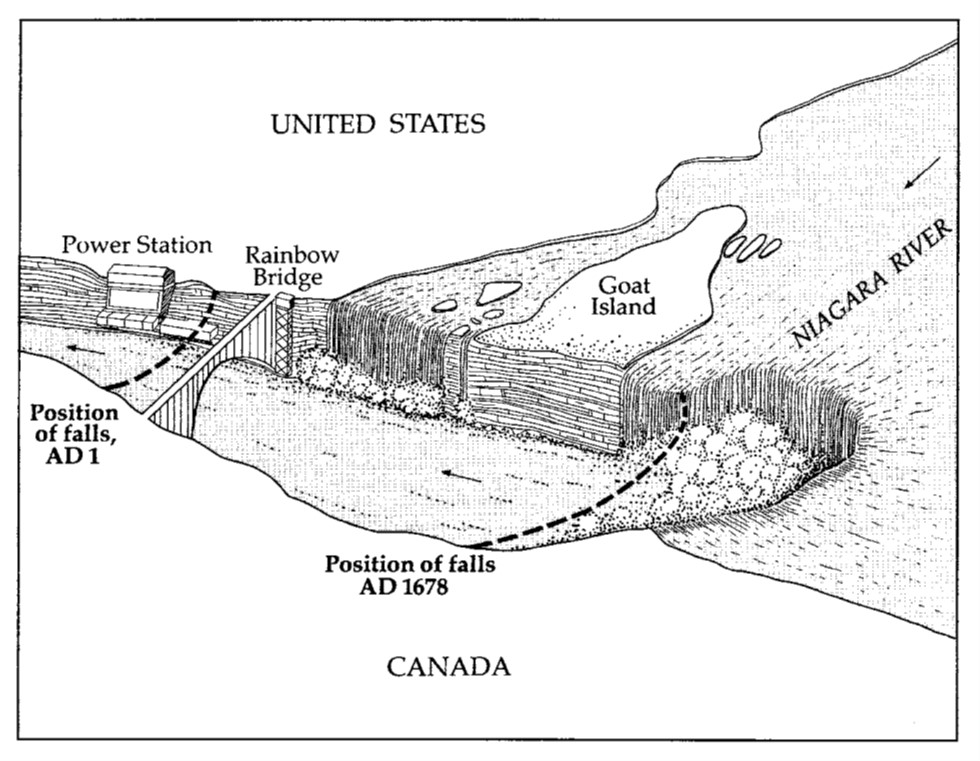
Thus, the Maid of the Mist is not the origin story of Niagara Falls, but explains certain features which were destroyed (the passage-way) or added later (the Horse-Shoe Fall). Thus, the Maid of the Mist must be seen as part of a constantly changing network of different stories about the Falls, which in the end had to be as flexible as the geographical phenomenon itself (if nothing else, even the Maid of the Mist exists in different versions). For various reasons the Maid of the Mist was deemed worth being told to the European newcomers, who in turn found it fascinating enough to write it down. It goes without saying that many of the reasons behind these complex negotiations cannot be reproduced or understood today, thus leaving a lot of space for new stories about Niagara Falls.
NOTES
[1] Not surprisingly, the same development marked the beginning of the conservation and preservation efforts on the Niagara Falls. As a natural wonder and (tourist) destination, the waterfalls had to be protected, even from their own destructive and fluid nature.
[2] For a more detailed analysis of the Maid of the Mist-story in connection to the settler colonial situation and with a specific focus on gender see Robinder Sehdevs work.
WORKS CITED
Berton, Pierre. Niagara: A History of the Falls. Toronto: McClelland & Stewart, 1992.
Burke, Andrew. Burke’s Descriptive Guide; or, the Visitors’ Companion to Niagara Falls: Its Strange and Wonderful Localities. Buffalo: Andrew Burke, 1852.
Gassan, Richard Harvey. The Birth of American Tourism: New York, the Hudson Valley, and American Culture, 1790-1830. Amherst: University of Massachusetts Press, 2008.
MacLeitch, Gail. Imperial Entanglements: Iroquois Change and Persistence on the Frontiers of the Empire. Philadelphia: University of Pennsylvania Press, 2011.
Morgan, Lewis H. League of the Ho-De’-No-Sau-Nee or Iroquois. New York: Dodd, Mead and Company, 1922.
Revie, Linda Lee. The Niagara Companion: Explorers, Artists and Writers at the Falls, from Discovery through the Twentieth Century. Waterloo, Ont.: Wilfrid Laurier UP, 2003.
Sehdev, Robinder Kaur. “Beyond the Brink: Indigenous Women’s Agency and the Colonisation of Knowledge in the Maid of the Mist Myth”. Cultural Studies Review 18:3 (2012), p. 240-262.
Strand, Ginger. Inventing Niagara: Beauty, Power, and Lies. New York: Simon & Schuster, 2008.
ILLUSTRATIONS
Figure 1: Legend of the White Canoe, Niagara, Postcard 1907. Niagara Falls Public Library, Filing Number D422829.
Figure 2: Bellin, Jacques Nicolas. Partie occidentale de la Nouvelle France ou Canada. 1755. https://de.wikipedia.org/wiki/Datei:1755_Bellin_Map_of_the_Great_Lakes_-_Geographicus_-_GreatLakes-bellin-1755.jpg; Accessed 04/24/2018.
Figure 3: Hennepin, Louis. “Saut ou chute d'eau de Niagara, qui se voit entre le Lac Ontario, & le Lac Erié”. 1689. https://commons.wikimedia.org/wiki/File:Chutes_du_Niagara_par_Hennepin.tiff; Accessed 04/27/2018.
Figure 4: Dow, Charles Mason. Anthology and bibliography of Niagara Falls, 1920. https://commons.wikimedia.org/wiki/File:Anthology_and_bibliography_of_Niagara_Falls_(1921)_(19362442752).jpg; Accessed 04/27/2018.
Figure 5: Berton, Pierre. Niagara: A History of the Falls, p. 19.

